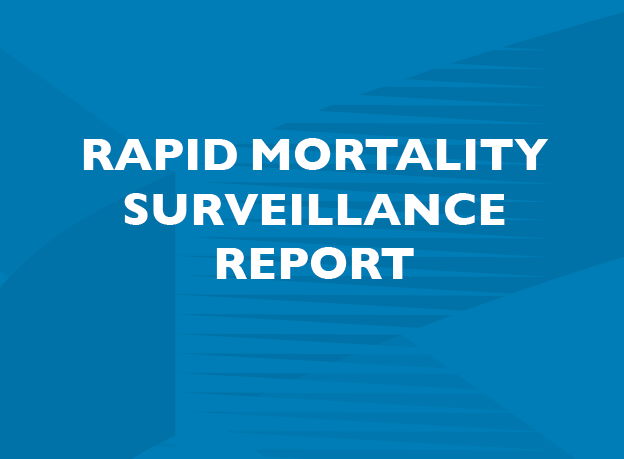Rapid Mortality Surveillance Reports
2019 & 2020
The Rapid Mortality Surveillance (RMS) Report has been providing empirical estimates of the mortality-based high-level indicators for monitoring health and the performance of the Department of Health since 2012. It provides information to track the National Development Plan (NDP) health goal to increase life expectancy at birth and selected outcomes outlined in the NDP and the Department of Health’s Strategic Plan for 2020/21 – 2024/25. Deaths registered on the National Population Register by the Department of Home Affairs are the main data source for the most recent estimates while less up-to-date estimates of the MMR and non-communicable disease premature mortality rates are based on adjusted cause-of-death data from Stats SA up to 2017 (being the most recent year for which vital registration data have been released). The Neonatal Mortality Rate is based on adjusted data from the District Health Information System (DHIS) up to 2020. Efforts to improve the completeness of death registration are still required and the delay in the release of cause-of-death statistics is a major concern in the context of the substantial increase in deaths in 2020.
This report shows that in 2020, the average life expectancy in South Africa was 64.7 years, a slight decline from the 65.3 years experienced in 2019 after having increased by more than 10 years since the low of 53.7 in 2005. The increase in life expectancy prior to 2019 is due to both the decrease in child mortality as well as the decrease in young adult mortality while the decrease in life expectancy in 2020 resulted from SARS-CoV-2. The average life expectancy dropped by 0.6 years between 2019 and 2020, a lower decline than has been measured in other countries, mostly developed countries, where this has been measured (Aburto et al. 2021). Furthermore, in contrast to the experience in these countries, the impact on life expectancy has been greater for females (drop of 1 year) than for males who experienced a decrease of 0.2 years. The muted impact of COVID-19 is mainly due to the impact of the severe lockdown (restricting social interaction and travel) and non-pharmaceutical interventions (NPIs) on non-COVID mortality. In the case of males, the marked reduction in the number of deaths from unnatural causes during periods of stringent lockdowns including alcohol restrictions has contributed to the lower decrease in their life expectancy.
View the complete Rapid Mortality Surveillance Report 2019 & 2020
2018
This is the eighth report based on the Rapid Mortality Surveillance (RMS) providing timely empirical estimates of the mortality-based high-level indicators for monitoring health and the performance of the Department of Health. The 2018 RMS provides life expectancy, child mortality and adult mortality information to track Outputs 1 and 2 of the health-related targets of the Negotiated Service Delivery Agreement (NSDA) and health- related targets of the Medium Term Strategic Framework (MTSF). Deaths registered on the National Population Register are the main data source. The Neonatal Mortality Rate is based on adjusted data from the District Health Information System (DHIS) up to 2018. The Maternal Mortality Ratio and non-communicable disease mortality rates could not be updated due to a delay in the release of cause-of-death data from Stats SA.
The 2018 report shows that the average life expectancy in South Africa is now over 64.8 years, having increased by more than 10 years since the low of 53.7 in 2005. Life expectancy at age 60, a useful indicator of the mortality experienced by older South Africans has shown little change since 2000. In 2018, the life expectancy at age 60 is 19.6 years for females and 15.9 years for males with an overall average of 17.9 years. Infant and under-five mortality rates reached a low of 23 and 32 per 1 000 live births, respectively, in 2017 but increased to 25 and 34 per 1 000 livebirths in 2018, respectively.
View the complete Rapid Mortality Surveillance Report 2018 Report

